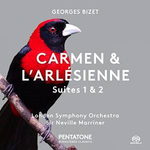|
Back
08/07/2016
Georges Bizet: Carmen Suites N° 1 and N° 2 – L’Arlésienne Suites N° 1 and N° 2 (arr. E. Guiraud)
London Symphony Orchestra, Sir Neville Marriner (Conductor)
Original recording: Walthamstow Town Hall, London, United Kingdom (June 1978) and remastered in Baarn, The Netherlands (April 2016) – 65’10
SACD Pentatone # PTC 5186 234 (Distributed by Naxos of America) – Booklet in English and German

   
Dressed as concert favorites are two pared down Suites of music collectivized by Georges Bizet’s ill-fated 1975 opéra-comique premiere and the well-received incidental music for Alphonse Daudet’s play, L’Arlésienne. We wind back the clock to Sir Neville Marriner and this historic recording which has been elegantly captured through Pentatone’s remastering of the original Philips Classics label.
Sir Neville Marriner can lay claim to being the most recorded conductor in the classical music world. His standards and measures are unequalled, yet the framework and fine tuning he brings to these Suites speak to the notion of British finery and wispy subtlety: while the journey is pleasant enough, the take is a tad pallid.
Mr. Marriner’s Carmen Suite softens the edges of Bizet’s decidedly sharply snappy and sassy opéra-comique. So much so that in the central portion of “Les Toréadors” the universally familiar melodic line brings with it smoother-than-normal legato via the strings. The technique can create too much malleability, especially when it comes to depicting Escamillo machismo inside the “Chanson du Toréador.” Similarly, the “Les Dragons d’Alcala” plods.
Collated by Bizet’s former student and friend, Ernest Guiraud, the Suites can take on their own sense of artistic vision through the movements’ sequential flexibility. Here, Sir Neville Marriner chooses to end the Suite N° 1 with a soufflé “Séguidille” while the “Aragonaise” utilizes the triangle as a replacement to the tambourine for percussive ornamentation. Marriner’s flutes chirp in sexy fashion during the “Habanera”, giving the piece seductive charm while the “Danse Bohème” snowballs into syncopated fury. [Incidentally, behind the “Habanera”, the “Nocturne” (Micaëla’s Act III aria) is omitted.]
When turning to L’Arlésienne, however, there’s noticeably more esprit vibrant. Unison violins confidently lead the “Prélude”, and the ensuing “Minuetto” gathers an assertive 3/4 time signature sans excessiveness. It was actually Ernest Guiraud who orchestrated several portions of this music; hence, the music has a distinctively fresh and popping outreach: the “Pastoral” moves and picks up a nicely brisk tempo (the best section of this entire CD) during the zesty woodwind inner section to delineate vinegary spontaneity though bathed by overall Provençe delicateness and charm.
Culled from his 1867 opera, La Jolie fille de Perth (ref: Mab/Le Duc de Rothsay, Act III), Marriner’s “Minuet” has a mind of its own for the conductor pushes the tempo faster on the inner harp accompagnato though the temperament is evenly flavored. Brass factors in heavily during the conclusive “Farandole” adding coruscation, but the piece has a sense of being too light. Perhaps it’s due to the replacement of the tambourine with hand pats on the drum. Guiraud’s vision sands down the edges of this open-chained Provençe jig-like dance. Nonetheless, Sir Neville Marriner doesn’t forget to gather the steam in the final bars.
There is urbane detail inside this recording that features the London Symphony Orchestra. Polite, refined and restrained, but it’s not peppery enough for personal taste.
Christie Grimstad
|